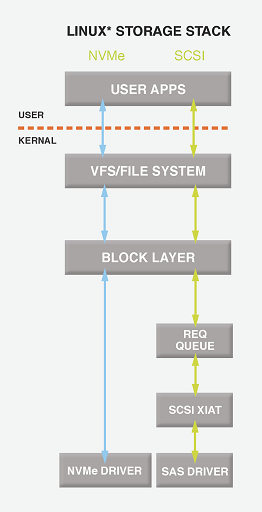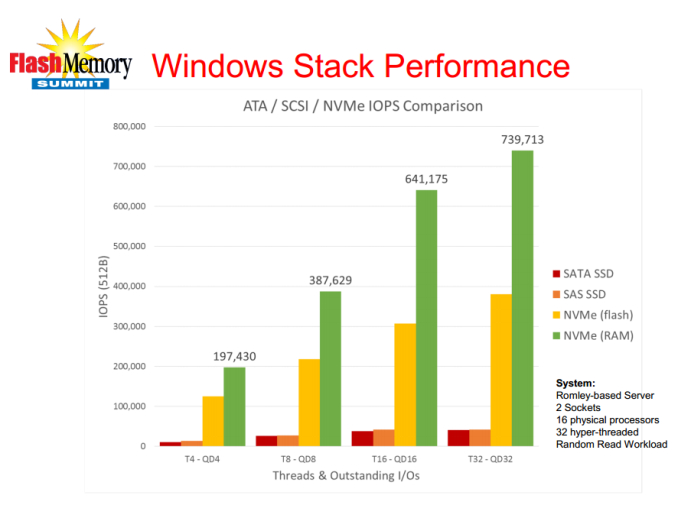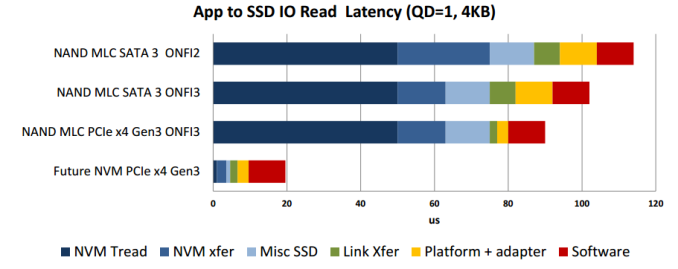Testing SATA Express And Why We Need Faster SSDs
by Kristian Vättö on March 13, 2014 7:00 AM EST- Posted in
- Storage
- SSDs
- Asus
- SATA
- SATA Express
NVMe vs AHCI: Another Win for PCIe
Improving performance is never just about hardware. Faster hardware can only help to reach the limits of software and ultimately more efficient software is needed to take full advantage of the faster hardware. This applies to SSDs as well. With PCIe the potential bandwidth increases dramatically and to take full advantage of the faster physical interface, we need a software interface that is optimized specifically for SSDs and PCIe.
AHCI (Advanced Host Controller Interface) dates back to 2004 and was designed with hard drives in mind. While that doesn't rule out SSDs, AHCI is more optimized for high latency rotating media than low latency non-volatile storage. As a result AHCI can't take full advantage of SSDs and since the future is in non-volatile storage (like NAND and MRAM), the industry had to develop a software interface that abolishes the limits of AHCI.
The result is NVMe, short for Non-Volatile Memory Express. It was developed by an industry consortium with over 80 members and the development was directed by giants like Intel, Samsung, and LSI. NVMe is built specifically for SSDs and PCIe and as software interfaces usually live for at least a decade before being replaced, NVMe was designed to be capable of meeting the industry needs as we move to future memory technologies (i.e. we'll likely see RRAM and MRAM enter the storage market before 2020).
| NVMe | AHCI | |
| Latency | 2.8 µs | 6.0 µs |
| Maximum Queue Depth |
Up to 64K queues with 64K commands each |
Up to 1 queue with 32 commands each |
| Multicore Support | Yes | Limited |
| 4KB Efficiency | One 64B fetch |
Two serialized host DRAM fetches required |
Source: Intel
The biggest advantage of NVMe is its lower latency. This is mostly due to a streamlined storage stack and the fact that NVMe requires no register reads to issue a command. AHCI requires four uncachable register reads per command, which results in ~2.5µs of additional latency.
Another important improvement is support for multiple queues and higher queue depths. Multiple queues ensure that the CPU can be used to its full potential and that the IOPS is not bottlenecked by single core limitation.
Source: Microsoft
Obviously enterprise is the biggest beneficiary of NVMe because the workloads are so much heavier and SATA/AHCI can't provide the necessary performance. Nevertheless, the client market does benefit from NVMe but just not as much. As I explained in the previous page, even moderate improvements in performance result in increased battery life and that's what NVMe will offer. Thanks to lower latency the disk usage time will decrease, which results in more time spend at idle and thus increased battery life. There can also be corner cases when the better queue support helps with performance.
Source: Intel
With future non-volatile memory technologies and NVMe the overall latency can be cut to one fifth of the current ~100µs latency and that's an improvement that will be noticeable in everyday client usage too. Currently I don't think any of the client PCIe SSDs support NVMe (enterprise has been faster at adopting NVMe) but the SF-3700 will once it's released later this year. Driver support for both Windows and Linux exists already, so it's now up to SSD OEMs to release compatible SSDs.













131 Comments
View All Comments
willis936 - Friday, March 14, 2014 - link
A 4.5GHz 4770k doesn't render my video, crunch my matlab, and host my minecraft at arbitrarily amazingly fast speeds, but it's a big step up from a Q6600 :pMrBungle123 - Friday, March 14, 2014 - link
That cable looks horrible, I'd rather them just move SSD's to a card.TEAMSWITCHER - Friday, March 14, 2014 - link
Second That! Hardware makers need to abandon SATA Express and start working on new motherboard form factors that would allow for attaching the flash drives directly to the motherboard. SATA Express is another compromised design-by-committee. Just what the struggling PC industry needs right now! Jeepers!!!iwod - Friday, March 14, 2014 - link
The future is Mobile. Where Laptop already overtook Desktop in numbers. So why another chunky ugly old hack for SSD? Has Apple not taught them a lesson where Design matters?And the speed, It is just too slow. We should at least be at 16Gbps, and since any of these standard aren't even coming out fast enough i would have expected the interface to leap to 32Gbps. Plenty of headroom for SSD Controller to improve and work on. And Intel isn't even bundling enough PCIe Lanes direct from CPU.
Why cant we build something that is a little future proof?
willis936 - Friday, March 14, 2014 - link
Cost matters. The first thing they'll tell you in economics 101 is that we live in a world with finite resources and infinite wants. There's a reason we don't all have i7 processors, 4K displays, and 780 GPUs right now. Thunderbolt completely missed it's window for adoption because the cost vs. benefit wasn't there and OEMs didn't pick it up. The solutions will be made as the market wants it. The reason the connector is an ugly hack is so you can have the option for high bandwidth single drives or multiple slower drives. It's not pretty and I'd personally like to just see it as a phy/protocol stack that uses the PCIe connector with some aneg to figure out if it's a SATAe or PCIe device but that might cause problems if PCIe doesn't handle things like that already.Your mobile connector will come, or rather is already here.
dszc - Saturday, March 15, 2014 - link
Thanks Kristian. Great article.I vote for PCIe / NVMe / M.2. SATAe seems like a step in the wrong direction. Time to move on. SATA SSDs are great for backward compatibility to help a legacy system, but seem a horrible way to to design a new system. Too big. Too many cables. Too much junk. Too expensive. SATAe seems to be applying old thinking to new technology.
watersb - Sunday, March 16, 2014 - link
I don't get the negative reactions in many of the comments.Our scientific workloads are disk-IO bound, rather than CPU-bound. The storage stack is ripe for radical simplification. SATAe is a step in that direction.
rs2 - Sunday, March 16, 2014 - link
This will never fly. For one thing the connectors are too massive. Most high-end mainboards allow 6 to 8 SATA drives to be connected, and some enthusiasts use nearly that many. That will never be possible with the SATAe connector design; there's just not enough space on the board.And the consuming 2 PCI-E lanes per connector is the other limiting factor. It's a reasonable solution when you just need one or two ports. But in the 8-drive case you're talking about needing 16 extra lanes. Where are those meant to come from?
willis936 - Sunday, March 16, 2014 - link
How many ssds do you plan to use at once? I can't think of a single use case where more than one ssd is needed, or even wanted if bandwidth isn't an issue. One ssd and several hard drives is certainly plausible. So there are 6 instead of 8 usable ports for hard drives. How terrible.Shiitaki - Monday, March 17, 2014 - link
So exactly what problem is this fixing? The problem of money, this is a pathetically attempt at licensing fees. SSD manufacturers could simply change the software and have their drives appear to the operation system as a pci-e based sata controller with permanently attached drive TODAY. It would her genius to be able to plug a drive into a slot and be done with it. We don't need anything new. We already have m-pci-e. Moving to a m-pci-ex4 would have been a better idea. The you could construct backplances with the new m-pci-ex4 connectors that aggrate and connect to a motherboard using a lci-ex8/16 slot.This article covers the story of a organization fighting desperately to not disappear into the history books of the computer industry.